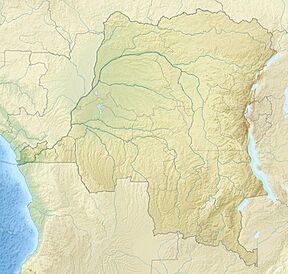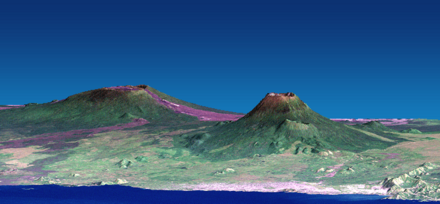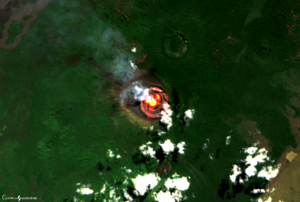Mount Nyiragongo facts for kids
Quick facts for kids Mount Nyiragongo |
|
|---|---|

Mount Nyiragongo viewed aerially in 2014
|
|
| Highest point | |
| Elevation | 3,470 m (11,385 ft) |
| Prominence | 1,443 m (4,734 ft) |
| Listing | Ribu |
| Geography | |
| Location | Democratic Republic of the Congo |
| Parent range | Virunga Mountains |
| Geology | |
| Formed by | Volcanism along the Albertine Rift |
| Mountain type | Stratovolcano |
| Last eruption | 22 February 2024 – present |
Mount Nyiragongo is an active stratovolcano located in the Democratic Republic of the Congo. It stands about 3,470 m (11,385 ft) tall. This volcano is part of the Virunga Mountains, which are linked to the Albertine Rift.
Nyiragongo is found inside Virunga National Park. It is about 12 km (7.5 mi) north of the city of Goma and Lake Kivu. The volcano's main crater is about two kilometres (1 mi) wide. This crater often holds a lava lake.
The lava lake inside Nyiragongo has sometimes been the largest known lava lake in recent history. Its depth changes a lot. Before the eruption in January 1977, the lake was about 600 m (2,000 ft) deep. After the January 2002 eruption, it was much lower, about 900 m (3,000 ft) below the rim. Since then, the lava level has slowly risen. Nyiragongo and its nearby volcano, Nyamuragira, cause 40% of all volcanic eruptions recorded in Africa.
Contents
Understanding Nyiragongo's Geology
Mount Nyiragongo partly sits on top of two older volcanoes, Baruta and Shaheru. Many smaller volcanic hills, called cinder cones, also surround it. These cones formed from eruptions on the volcano's sides.
Nyiragongo's cone is made of volcanic ash and rock pieces, along with lava flows. The lava from Nyiragongo is special because it has very little silica. This makes the lava extremely fluid. While most lava flows move slowly, Nyiragongo's lava can rush downhill very fast. It can reach speeds of up to 100 km/h (60 mph). This makes its eruptions especially dangerous.
Nyiragongo's Eruption History
We don't know exactly how long Nyiragongo has been erupting. However, it has erupted at least 34 times since 1882. Many times, it has been continuously active for years. This activity often includes a bubbling lava lake in its crater. Scientists confirmed the lava lake's existence in 1948. They found that its size, depth, and temperature changed over time.
The lava lake is still active today. As of 2020, the lake is mostly inside a steep-sided cone on the crater floor. This cone is about 18 m (60 ft) high and 180 m (600 ft) wide.
The 1977 Eruption
From 1894 to 1977, Nyiragongo's crater held an active lava lake. On January 10, 1977, cracks appeared in the crater walls. The lava lake drained out in less than an hour. The lava flowed down the volcano's sides at speeds up to 60 km/h (37 mph) on the upper slopes. This was the fastest lava flow ever recorded at that time. It covered villages and sadly killed at least 50 people in Kibati and Moniki.
Within 30 minutes, the lava lake was empty. The lava flowed north, south, and west of the volcano. It's rare for such a steep volcano to have a lake of such fluid lava. Nyiragongo is close to many towns, which makes its eruptions very risky. The 1977 eruption showed how dangerous Nyiragongo is. Because of this, it was named a Decade Volcano in 1991. This means it needs special study.
The 2002 Eruptions
Lava lakes formed again in the crater during eruptions in 1982–1983 and 1994. Another big eruption started on January 17, 2002. This happened after several months of increased earthquake activity and gas vents. A 13-kilometre (8.1 mi) crack opened on the volcano's south side. It quickly spread towards the city of Goma. Goma is the capital of the province and sits on the northern shore of Lake Kivu.
Lava poured from three small cones at the end of the crack. It flowed in a stream 200 to 1,000 metres (660 to 3,280 ft) wide and up to 2 metres (7 ft) deep through Goma. Warnings were given, and 400,000 people left the city. They went across the Rwandan border into nearby Gisenyi. The lava covered the northern part of the runway at Goma International Airport. It also reached Lake Kivu. People worried that the lava might cause dangerous gases in the lake to rise to the surface. This could release large amounts of carbon dioxide and methane, like what happened at Lake Nyos in Cameroon in 1986. Luckily, this did not happen. Scientists still watch the area closely.
About 245 people died in the 2002 eruption. Most died from breathing in carbon dioxide or from buildings collapsing due to the lava and earthquakes. Lava covered 13 percent of Goma, about 1.8 square miles (4.7 km2). Nearly 120,000 people lost their homes.
After the eruption stopped, many earthquakes shook Goma and Gisenyi. These quakes continued for about three months. They caused more buildings to fall down. Six months after the 2002 eruption, Nyiragongo erupted again.
Ongoing Dangers
Sometimes, carbon dioxide gas seeps from the ground in certain spots. This gas can be very dangerous, especially for children, if there's no wind to blow it away. This is known locally as 'mazuku'. On March 8, 2016, scientists found a new vent in the northeast part of the crater. This followed reports of rumbling sounds from the volcano. Some people worried this could lead to an eruption from the side of the volcano. In 2020, observers saw the lava lake rising. This and other signs suggested another eruption might be coming.
The 2021 Eruption
A new eruption began on May 22, 2021. Lava flowed towards the Goma airport and then towards the city center of eastern Goma. The military governor of the North Kivu province confirmed the eruption started around 5:00 PM GMT. A main road to Beni was cut off by the lava. Authorities told people in Goma to leave their homes, and thousands evacuated. Electricity was also cut off in many areas after the eruption. By May 27, 2021, 37 people were missing and thought to be dead after lava reached the edge of Goma. The eruption caused at least 32 deaths, mostly from car crashes during the evacuation.
Monitoring the Volcano
A team of scientists at the Goma Volcanic Observatory (GVO) constantly watches Mount Nyiragongo. They get earthquake data every four minutes and temperature data every ten minutes. However, the future funding for the GVO is uncertain. The World Bank decided in 2020 to stop its financial support.
More to Explore
- Decade Volcanoes
- List of volcanic eruptions by death toll
- List of volcanoes in the Democratic Republic of the Congo




